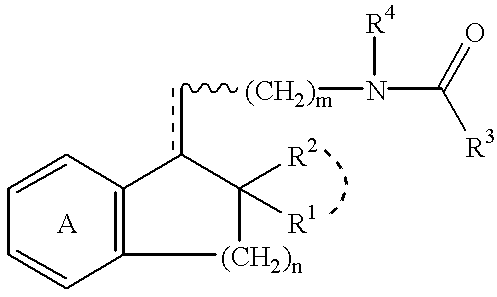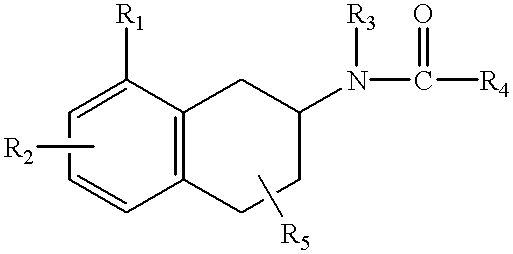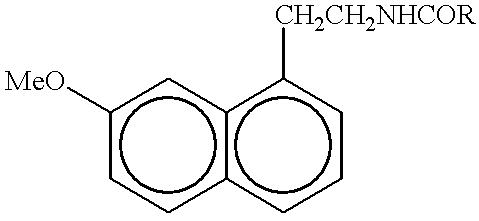Benzocycloalkene compounds, their production and use
- Summary
- Abstract
- Description
- Claims
- Application Information
AI Technical Summary
Benefits of technology
Problems solved by technology
Method used
Image
Examples
reference example 1
(1,2,3,4-tetrahydro-7-methoxy-1-naphthylidene)acetonitrile
To a solution of 60% sodium hydride (6.24 g, 156 mmol) in tetrahydrofuran (100 ml) was gradually added dropwise, under ice-cooling, diethyl cyanomethyl phosphonate (30.4 g, 172 mmol). The mixture was stirred for 15 minutes. To the reaction mixture was then added dropwise a solution of 7-methoxy-1-tetralone (25.2 g, 143 mmol) in THF (50 ml). The reaction mixture was heated for 3 hours under reflux. The reaction mixture was poured into water, and the organic layer was subjected to extraction with chloroform. The extract solution was washed with brine and water, which was dried over anhydrous magnesium sulfate, followed by distilling off the solvent under reduced pressure. The residue was purified by means of a silica gel column chromatography (hexane:ethyl acetate=9:1) to give the above-titled compound (a mixture of isomers) (28 g, yield 98%, oil). The above-titled compound (a mixture of isomers) was further purified by a silic...
reference example 2
(Z)-(1,2,3,4-Tetrahydro-7-methoxy-1-naphthylidene)acetonitrile
To a solution of (1,2,3,4-tetrahydro-7-methoxy-1-naphthylidene)acetonitrile (4.0 g, 20 mmol) in ethanol (10 ml) were added a saturated ammonia / ethanol solution (5 ml) and Raney cobalt (ODHT-60, 1 g). The reaction mixture was stirred for 3.5 hours at room temperature under hydrogen atmosphere (about 4 kgf / cm.sup.2). The Raney cobalt was filtered off, then the solvent was distilled off under reduced pressure. To the residue was added dilute hydrochloric acid, then the organic layer was subjected to extraction with ethyl acetate. The extract solution was washed with a saturated aqueous solution of sodium hydrogencarbonate and water, which was dried over anhydrous magnesium sulfate, followed by distilling off the solvent under reduced pressure. The residue was purified by means of a silica gel column chromatography to give the above-titled compound (yield 2.14 g, oil).
NMR(CDCl.sub.3) .delta.: 1.87-2.02(2H,m), 2.54-2.64(2H,m),...
reference example 3-a
1-(2-Aminoethylidene)-7-methoxy-1,2,3,4-tetrahydronaphthalene
To a solution of (1,2,3,4-tetrahydro-7-methoxy-1-naphthylidene)acetonitrile (15.0 g, 25 mmol) in ethanol (100 ml) were added a saturated ammonia / ethanol solution (30 ml) and Raney nickel (W-2, 3 g). The reaction mixture was stirred for 8 hours at 50.degree. C. under hydrogen atmosphere (3-4 kgf / cm.sup.2). The Raney nickel was filtered off, then the solvent was distilled off under reduced pressure to give the above-titled compound (a mixture of isomers (20.4 g, yield 80%, oil). This compound was used in the subsequent reaction without further purification.
PUM
| Property | Measurement | Unit |
|---|---|---|
| Molar density | aaaaa | aaaaa |
| Molar density | aaaaa | aaaaa |
| Molar density | aaaaa | aaaaa |
Abstract
Description
Claims
Application Information
 Login to View More
Login to View More - R&D
- Intellectual Property
- Life Sciences
- Materials
- Tech Scout
- Unparalleled Data Quality
- Higher Quality Content
- 60% Fewer Hallucinations
Browse by: Latest US Patents, China's latest patents, Technical Efficacy Thesaurus, Application Domain, Technology Topic, Popular Technical Reports.
© 2025 PatSnap. All rights reserved.Legal|Privacy policy|Modern Slavery Act Transparency Statement|Sitemap|About US| Contact US: help@patsnap.com



